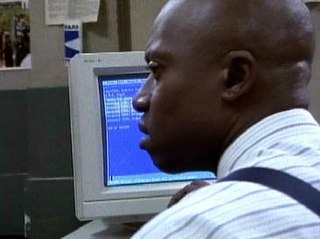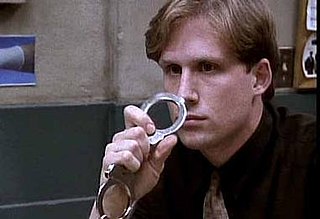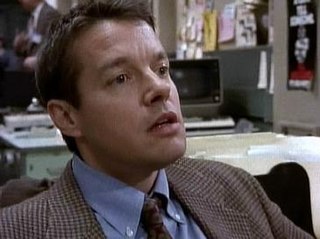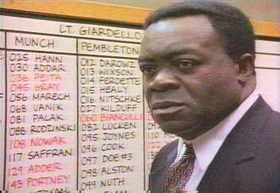Related Research Articles
Homicide: Life on the Street is an American police drama television series chronicling the work of a fictional version of the Baltimore Police Department's Homicide Unit. Created by Paul Attanasio, it ran for seven seasons and 122 episodes on NBC from January 31, 1993, to May 21, 1999, and was succeeded by Homicide: The Movie (2000), which served as the series finale. The series was created by Paul Attanasio and based on David Simon's book Homicide: A Year on the Killing Streets (1991). Many of the characters and stories used throughout the show were based on events depicted in the book.

Francis Xavier "Frank" Pembleton is a fictional homicide detective on the television drama series Homicide: Life on the Street portrayed by Emmy Award–winning actor Andre Braugher. He is a primary character of the show through the first six seasons. Although the show featured an ensemble cast, Pembleton would become the fan favorite and is often identified by as the show's signature character. He is based on Baltimore Police Department Detective Harry Edgerton, who, like Pembleton, was an eccentric New York–born African American detective in the BPD homicide unit featured in David Simon's book Homicide: A Year on the Killing Streets. The character also appeared in the Law & Order episode "Charm City".

Detective Michael Scott Kellerman is a fictional character on the television drama series Homicide: Life on the Street portrayed by Reed Diamond. He is a main character from seasons 4–6 (1995–98).

The first season of Homicide: Life on the Street, an American police procedural drama television series, originally aired in the United States on NBC between January 31 and March 31, 1993. The show was created by Paul Attanasio, with film director Barry Levinson and television writer and producer Tom Fontana serving as executive producers. Adapted from David Simon's 1991 non-fiction book Homicide: A Year on the Killing Streets, the season followed the fictional detectives of Baltimore Police Department homicide unit and the murder cases they investigate. The show was broadcast on Wednesdays at 9 p.m. EST, with the exception of the series premiere, which aired immediately after Super Bowl XXVII.

Timothy Bayliss is a fictional character on Homicide: Life on the Street, played by Kyle Secor and one of the few main characters to last the entire run of the show. He was loosely based on real-life Baltimore homicide detective Thomas Pellegrini, featured in David Simon's book Homicide: A Year on the Killing Streets, though Pellegrini was reportedly not at all a fan of his fictional alter ego. The character also appeared in the Law & Order episode "Charm City."

Alphonse Michael 'Gee' Giardello Sr. is a fictional character from the television drama Homicide: Life on the Street. The character was played by Yaphet Kotto. He is based on Baltimore Police Department Shift Lieutenant Gary D'Addario, a member of the BPD homicide unit described in David Simon's book Homicide: A Year on the Killing Streets which served as the inspiration for the series as a whole. The character also appeared in the Law & Order episode "Baby, It's You".

J.H. Brodie is a fictional character in the television series Homicide: Life on the Street. He appeared in a recurring role in the show's fourth season and was a regular in the show's fifth season, after becoming an official crime scene videographer.

Stuart Gharty is a fictional character played by Peter Gerety in the television series Homicide: Life on the Street.

Rene Sheppard is a fictional character in Homicide: Life on the Street, played by Michael Michele.
"Blood Ties" is the three-episode sixth season premiere of the American police drama television series Homicide: Life on the Street. The episodes constitute the 78th, 79th and 80th overall episodes of the series. They originally aired on NBC on October 17, 24 and 31, 1997, respectively.

"Gone for Goode" is the first episode of the first season of the American police drama television series Homicide: Life on the Street. It originally aired on NBC in the United States on January 31, 1993, immediately following Super Bowl XXVII. The episode was written by series creator Paul Attanasio and directed by executive producer Barry Levinson. "Gone for Goode" introduced regular cast members Daniel Baldwin, Ned Beatty, Richard Belzer, Andre Braugher, Wendy Hughes, Clark Johnson, Yaphet Kotto, Melissa Leo, Jon Polito, and Kyle Secor.

"Three Men and Adena" is the fifth episode of the first season of the American police drama television series Homicide: Life on the Street. It originally aired on NBC in the United States on March 3, 1993. The episode was written by executive producer Tom Fontana and directed by Martin Campbell. In the episode, Pembleton and Bayliss have a 12-hour limit to elicit a confession from Risley Tucker for the murder of 11-year-old Adena Watson. The episode takes place almost entirely within the confines of the police interrogation room with the three actors.
"Ghost of a Chance" is the second episode of the first season of the American police drama television series Homicide: Life on the Street. It originally aired on NBC in the United States on February 3, 1993. The teleplay was written Noel Behn based on a story by executive producer Tom Fontana, and the episode was directed by Martin Campbell. In it Bayliss begins his investigation into the murder of 11-year-old Adena Watson, Munch and Bolander investigate the unusual death of an elderly man, and Howard insists she is receiving advice about her murder case from a ghost.

"Son of a Gun" is the third episode of the first season of the American police drama television series Homicide: Life on the Street. It originally aired on NBC in the United States on February 10, 1993. The teleplay was written by James Yoshimura based on a story by executive producer Tom Fontana, and the episode was directed by Nick Gomez. In the episode, recurring character Officer Thormann is shot while on duty, and his close friend Crosetti takes the investigation personally.

"A Shot in the Dark" is the fourth episode of the first season of the American police drama television series Homicide: Life on the Street. It originally aired on NBC in the United States on February 24, 1993. The teleplay was written by Jorge Zamacona based on a story by executive producer Tom Fontana, and the episode was directed by Bruce Paltrow. In the episode, Crosetti focuses his investigation into the shooting of Officer Thormann on one suspect, while Lewis continues to investigate. Meanwhile, Pembleton and Bayliss pursue different leads in the murder case of 11-year-old Adena Watson.
"Law & Disorder" is the 15th episode of the third season of the American police drama television series Homicide: Life on the Street. It originally aired on NBC on February 24, 1995. The episode was written by Bonnie Mark and Julie Martin and directed by John McNaughton. The episode concludes elements of a storyline about the shooting of Beau Felton, Kay Howard, and Stanley Bolander.
"Fallen Heroes" is a two-part episode that concludes the sixth season of the American police drama television series Homicide: Life on the Street. It comprises the 99th and 100th overall episodes of the series, and originally aired on NBC in the United States on May 1, 1998 and May 8, 1998.

Paul Falsone is a fictional character in Homicide: Life on the Street, portrayed by Jon Seda. He is a police detective of the Baltimore Police Department. Born on October 14, 1968, Falsone was introduced as a long-time member of the Auto Squad at the end of Season 5, where his natural talents proved useful in solving vehicle-related crimes. However, when the department began a rotation program, in which detectives would be periodically reassigned to new units, Falsone was transferred to the homicide shift commanded by Al Giardello. After three months, Giardello expressed satisfaction with Falsone's work and requested that he remain with the unit.
"Zen and the Art of Murder" is an episode of the seventh season of the American police drama television series Homicide: Life on the Street. It originally aired on NBC on April 2, 1999. The episode was written by Lloyd Rose and directed by Miguel Arteta. The episode is significant in the story arc of Laura Ballard's romance with Paul Falsone; fearful that their secret romance will be discovered, Falsone ends the relationship.
"Nearer My God to Thee" is the third season premiere of the American police drama television series Homicide: Life on the Street, and the fourteenth overall episode of the series. It originally aired on NBC in the United States on October 14, 1994. In the episode, the homicide department is assigned to the politically volatile murder of a beloved social worker, whose body is found wearing nothing but a pair of white gloves. Meanwhile, Felton struggles with marital problems, while Lewis and Munch try to find a business partner with whom to open a bar.
References
- ↑ Kalat, David (1998). Homicide: Life on the Street: The Unofficial Companion . Los Angeles, California: Renaissance Books. ISBN 1-58063-021-9.
- ↑ Buscemi, Steve (2005). Homicide Life on the Street - Season 6 (episode "Finnegan's Wake") [DVD]. A&E Home Video.
- ↑ "Charles Durning, Emmys.com" . Retrieved November 15, 2012.